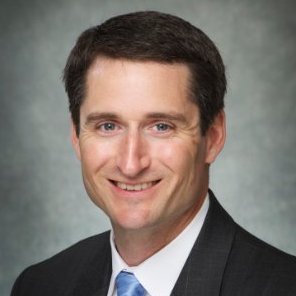Company executives, others explored the continuum of care and property transaction drivers at the recent annual healthcare real estate conference in Scottsdale, Ariz.

Jared Stark

John Marshall
INDIANAPOLIS, Jan. 25, 2017 – What role does real estate play in the healthcare industry’s efforts to provide a continuum of care? What are the industry’s strategic drivers for real estate decisions? Two Duke Realty healthcare executives – Senior Vice President Jared Stark and Vice President John Marshall – shared their expertise on those and other topics during two separate educational panels at the Dec. 7-8 RealShare Healthcare Real Estate Conference in Scottsdale, Ariz.
Navigating Change: Real Estate and the Continuum of Care
In addition to Moderator John Marshall, the continuum of care panel included Alain Beaini, Executive Director of the Devenney Group; Jason Signor, CEO & Partner, Caddis Healthcare Real Estate; Peter Trice, Partner, The Innova Group; and Michael Vaughn, Senior Vice President of Walker & Dunlop.
Panelists discussed the continuum of care, i.e., the process of proactively analyzing a population, providing services for all levels and stages of care, improving access to healthcare and the overall patient experience, and managing diseases of the population over time. It also may refer to care provided from birth to end of life. Several panelists said they’ve seen few cases of true continuum of care across the country because it can be challenging to implement while trying to keep costs down and revenues high. Some said that while they’ve seen more and more freestanding emergency departments (EDs), which enhance access to healthcare, these usually aren’t part of a comprehensive continuum of care platform.
Several panelists mentioned innovative new models that improve access and the patient experience such as a mobile ED ambulance that treats people in the ambulance at their home rather than transporting them to the hospital. One panelist mentioned a human kindness model that improves the built environment and provides amenities throughout the entire system that positively affects everyone, including patients, physicians, staff and visitors.
Mr. Marshall of Duke Realty noted, “In a Mortenson survey conducted last year, 68 percent of providers directly correlated improving the quality of the facility to improving patient outcomes. This is something we all probably realize as obvious, but this quantifies it.”
Other trends mentioned included consolidation of clinical services, consolidation of physician groups and more development of end-of-life care. It was noted that healthcare for seniors usually provides a true continuum of care, including senior apartments, independent living, assisted living, memory care, skilled nursing and post-acute rehab.
The panel discussed the growth of outpatient facilities and retail clinics, which are more convenient and accessible for consumers than large hospital campuses. Mr. Marshall noted: “I saw an Advisory Board statistic that 25 percent of consumers used a retail clinic in 2015, up from 15 percent in 2013. Ten years ago we would never do this because these facilities didn’t exist. Now, however, health providers that implement retail clinics can offer simple, convenient healthcare services to consumers but also navigate them to their other access points for a continuum of care.”
The panelists said they’re seeing a growing trend in healthcare facilities of using space more efficiently and cost effectively, such as offering evening wellness classes, nighttime pediatric clinics, ambulatory settings for behavioral health and more.
Mr. Marshall noted, “A health provider recently told me that they’re essentially a real estate company. They lease, own and manage millions of square feet and, short of the clinical dollars they spend and overall employee overhead, these are the most expensive things they have. I think the biggest challenge we face is helping them understand strategically how they can align their real estate with their overall delivery network and cost structure to lower the cost of occupancy.”
Deal Flow Drivers: Site Selection, Demand & Capital Flow
Joining Mr. Stark on this panel were Moderator Matt Gilbert, Vice President Brokerage, Healthcare, with Transwestern; Jim Croy, Senior Vice President, HCP MOB Inc.; Julie Johnson, Principal, Avison Young; and Jackie Lundblad, Vice President, Strategic Planning, Ensemble Real Estate.
The panelists discussed the Medicare Access and CHIP Reauthorization Act (MACRA), which is transferring value-based purchasing from strictly Part A to Part B reimbursement from Medicare. Physicians will have new risk-based contracts in which they have the potential to lose money if they don’t meet specific goals regarding healthcare quality, resource use, advancing care information and clinical practice improvement. The new rules will begin with a reporting period in 2017 and the changes in Medicare reimbursements will take effect in 2019. The panelists said they expect this will result in more consolidations and expansions of physician practices to spread out the risk.
Mr. Stark of Duke Realty noted, “I think that a large percentage of the independent physician practices with less than 25 or 50 members will either go out of business or be acquired by a health system. Over the last five to 10 years, we’ve seen a big increase in health systems acquiring physician practices but then it’s leveled off a little. Now I think we’re in for a whole new era of acquisitions.”
Other panelists said MACRA will result in health systems seeking new capital partners or third parties to handle implementation and assume and manage risk. One panelist said this will likely result in a shift to more virtual primary care, home care and community care networks. Many said they expect health systems will need larger healthcare facilities to house the consolidated organizations or to serve as a medical call center rather than a clinic.
It was also mentioned that hospitals and health systems will need to provide support so their physicians achieve compliance, including developing specific metrics to achieve organizational goals consistent with MACRA. Mr. Stark noted, “Hospitals and health systems will not only have to spend capital to acquire practices, they’ll also have to invest in an electronic health record system to help physicians meet the requirements of MACRA.
But they also need to continue investing in quality and implementing their real estate strategy by carefully selecting sites that provide key access points out in the community.”
The panel also discussed changes in the Center for Medicare and Medicaid Services’ (CMS) site-neutral payment rule. This rule stipulates that reimbursement for services provided by off-campus hospital outpatient departments (HOPDs) will be reimbursed at the same (lower) rate as on-campus hospital-based outpatient departments. Changes in this rule are reducing payments for new HOPDs to align with the physician practice fee schedule versus hospital rates. It was mentioned that there’s a growing trend of health systems building micro hospitals and freestanding emergency departments, which enables them to bill at traditional hospital rates. They said they anticipate CMS may continue to closely scrutinize these arrangements.
The panel was asked if they think the results of the presidential election will have a major, minor or no effect on the Patient Protection and Affordable Care Act (PPACA). Some said it remains to be seen what the effect will be, and others said the new administration will significantly affect PPACA but that it may take several years. The panelists said the hottest trends in the healthcare real estate sector are employed physicians and consolidation. The panelists all agreed that the healthcare real estate market fundamentals are strong to very strong.
About Duke Realty
Duke Realty is a national commercial real estate company specializing in the ownership, management and development of medical office properties, complemented by a large portfolio of industrial assets. Duke Realty (NYSE:DRE) owns, maintains an interest in or has under development 138 million square feet of space in more than 21 top-tier markets nationwide. The healthcare segment of Duke Realty’s portfolio totals more than 6.7 million square feet, and includes properties ranging from medical office buildings to rehabilitation facilities and from ambulatory care centers with diagnostics, oncology and surgery services to one of the nation’s largest cancer centers. Duke Realty also has on-staff a team of healthcare professionals who are well-versed in the unique demands of medical providers and have proven experience in providing hospitals and physician groups comprehensive planning, development, ownership and facility management services. More information about Duke Realty’s healthcare real estate capabilities is available at www.dukerealty.com/healthcare. Duke Realty also can be followed on Twitter, LinkedIn, Facebook and YouTube.
The full content of this article is only available to paid subscribers. If you are an active subscriber, please log in. To subscribe, please click here: SUBSCRIBE





